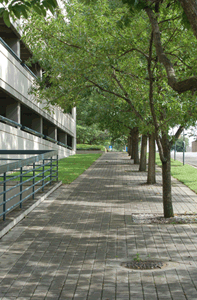
Alabama’s Urban and Community Forestry (U&CF) Program promotes the development, care, and protection of the estimated one-quarter billion trees in the State, growing where people live, work, and play. These trees help our economy as forest products, by saving energy, increasing property values, and stimulating sales. They protect our environment by cleaning our air and water, stabilizing the soil, and supporting wildlife. They improve our health and enrich our lives by providing shade, blocking UV-B radiation, improving hospital recovery times, and providing many other aesthetic and health benefits. These many benefits are maximized, and the few costs minimized by proper urban forest management.
The U&CF Program encourages management of the urban forest primarily through the following activities:
Grant Opportunity! "Trees4AL" is a match-free, tree planting grant with awards ranging from $40,000 to $100,000 for planting trees in disadvantaged areas of Alabama. Apply now! Those eligible to apply are local governments, non-profit organizations, tribal entities, and educational institutions. Funds MUST be used in Alabama for disadvantaged communities as identified at the time of application by the Climate and Economic Justice Screening Tool found at https://screeningtool.geoplatform.gov/en/. The full request for applications may be found at Here. Applications are submitted online from the Submittable link at https://alabamaforestrycommission.submittable.com
Click the hyperlinks shown in blue for more detailed information on the U&CF Programs. Also, another excellent online resource for cities working to improve their urban canopy and improve their green spaces is the Vibrant Cities Lab. This website is a joint project of the U.S. Forest Service, American Forests and the National Association of Regional Councils, merging the latest research with best practices for implementing green infrastructure projects in your community.
Employment of an ISA Certified Arborist is strongly recommended for all significant tree work. Tree care around homes, streets, and public areas is serious business, and only a fully-trained professional can manage urban trees to preserve property values, increase storm resilience, and ensure the safety of the people who enjoy the benefits of urban trees. A list of Certified Arborists may be found at www.isa-arbor.com.
For more information on the U&CF Program, please contact Dale Dickens at (334) 467-7971.
“The Society of American Foresters (SAF) believes actions and practices that strengthen and improve urban and community forests are vital to the social, economic, and environmental well-being of the nation. As the nation becomes increasingly urbanized, the sustainable management of urban and community forests will be increasingly critical to accomplishing the nation’s goals related to recreation, human health, air quality, energy consumption, water quality, invasive species, fire protection, and others.”